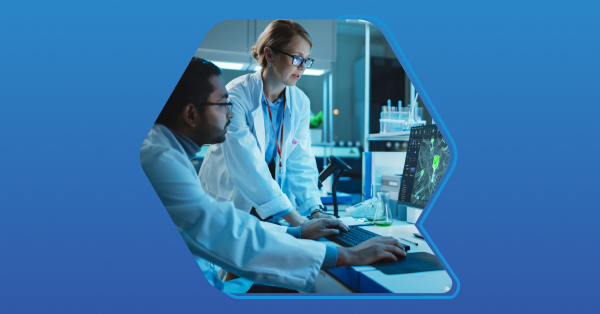LIMS vs ERP: Which Software is Best for Labs?


Labs are generating and managing more data than ever before, compelling lab managers to seek increasingly robust software solutions to manage this data explosion.
For lab directors already juggling increasing workloads with static resources, this choice isn't just another technology decision; it's a strategic imperative that directly affects your team's performance, your lab's reputation, and your operational success.
If you select a LIMS, you’re in good company. As of 2023, 70% of pharmaceutical companies and 65% of clinical research organizations reported using a LIMS. But still, ERPs have their place, especially for pharmaceutical and biotech labs, where they can be popular for quality control and inventory management.
In this guide, we’ll break down the key differences between an ERP and a LIMS to help you make the right choice for your lab.
The Challenges Modern Labs Face Today: Why Software is Necessary
Today's laboratories face unprecedented challenges in data management.
Labs are overwhelmed by a wave of information while trying to maintain compliance and quality standards, and the pressure is only increasing.
For lab directors, this creates a perfect storm of critical challenges:
- Resource constraints: When sample volume increases 7.5% annually, but staffing remains frozen, forcing your team to process more with the same resources.
- Compliance: When an FDA inspector arrives for an unannounced audit, they demand complete documentation and audit trails.
- Inventory disruptions: When critical reagents expire or deplete unexpectedly, halting testing and delaying results for important clients.
The cost of inadequate data management extends beyond compliance risks; it directly impacts your lab's bottom line through inefficiencies, errors, and missed opportunities for process optimization.
As testing methodologies grow more sophisticated and clients demand faster turnaround times, the limitations of traditional documentation systems become increasingly apparent. This is where the crucial decision between an ERP and a LIMS becomes a strategic imperative rather than just another technology investment.
What is a LIMS?
A LIMS (Laboratory Information Management System) is a comprehensive and robust software platform sold to labs to manage data, inventory, and automate workflows.
While cloud-based LIMS have become popular in modern labs in the past decade, they are hardly a new concept. The first LIMS hit the market in the 1970s, and they have been an integral part of an efficient and organized lab ever since.
LIMS have evolved into sophisticated systems that support a wide range of laboratory activities, including:
- Managing samples and tests
- Generating reports
- Providing a portal for customers
- Handling billing and inventory
- Syncing data from lab instruments
- Automating repetitive tasks
But where a LIMS truly excels is in organizing data at scale and streamlining your lab’s operations.
Here are the most common use cases for a LIMS:
- Sample tracking and management: A good LIMS will be an excellent asset for efficiently managing high volumes of samples from receipt to reporting.
- Workflow automation: Look for a LIMS with automation features that allow you to streamline and ensure data integrity.
- Data integration and reporting: A LIMS can provide centralized storage and easy access to laboratory data, enabling quick report generation and historical data retrieval.
- Instrument integration: For a lab with many types of instruments, a LIMS can be invaluable when it comes to seamlessly connecting them while automating data capture.
- Compliance and documentation: While not every LIMS can support quality management and compliance, some (like QBench) provide out-of-the-box features to help labs meet regulatory requirements.
As you can see, a LIMS can be a great asset for a lab looking to scale and better organize its operations. Be sure to check out our free guide on how to choose the best LIMS for your lab.
What is an ERP?
An ERP (Enterprise Resource Planning) is a software platform designed for general business management, not specifically for laboratories. These tools excel at connecting finance, HR, and supply chain operations across an organization, but weren't built with scientific workflows in mind.
An ERP is somewhat similar to a LIMS, as it can help automate processes and workflows, but unlike a LIMS, an ERP is designed with a generic business purpose in mind rather than lab-specific needs.
ERPs can be particularly valuable for larger organizations, where the complexity of operations can make maintaining consistency and efficiency across departments challenging. If you're considering an ERP, be forewarned: Gartner estimates that 55% to 75% of all ERP projects fail to meet their objectives, and a large percentage of ERP implementations go over budget, according to Statistica.
When it comes to labs, an ERP can be used for the following:
- Sample Management: Track and manage samples from their receipt to storage to testing, ensuring timely and accurate processing.
- Quality Assurance and Control: Monitor and document test results, calibrations, and validations, ensuring that products or samples meet required standards and specifications.
- Inventory Management: Keep track of chemicals, reagents, consumables, and equipment, automating re-order levels and ensuring that critical resources are always available.
- Project and Workflow Management: Plan, schedule, and monitor testing projects, optimizing laboratory workloads, and ensuring timely completion of tests and analyses.
Even with heavy customization, ERP modules rarely provide chain‑of‑custody, instrument drivers, or regulatory audit trails out of the box. But again, an ERP is a more generalized piece of software, so let’s explore the differences between an ERP and LIMS next.
How is an ERP different from a LIMS?
On the surface, an ERP and a LIMS seem relatively similar.
Both can be used to manage data, streamline processes, and help an organization scale. The key difference to be aware of, though, is that an ERP is much more generalized, whereas a LIMS is specialized to the use cases of a lab.
Both a LIMS and an ERP can:
- Help you capture, store, and manage data.
- Automate workflows and processes.
- Integrate different systems.
However, a LIMS is designed specifically for the needs of a lab and therefore, will be much better suited to your use case than an ERP, which is more generalized and designed for a broader set of use cases. An ERP may work initially, but as your lab scales and your processes become more complex or need to adapt, you may need more support.
A flexible and configurable LIMS can scale with your lab and support you as processes and workflows change. If you purchase a cloud-hosted LIMS, you can rest assured that a team of software engineers will continue to deliver features with the specific use cases of a lab in mind.
Can an ERP be Used in Place of a LIMS?
Enterprise Resource Planning (ERP) systems and Laboratory Information Management Systems (LIMS) serve different primary functions, but there are some scenarios where an ERP system might substitute for a LIMS, albeit with limitations.
- Small labs with simple sample tracking needs: If a lab has minimal sample tracking needs, then the inventory management capabilities of an ERP may be enough.
- Manufacturing companies with quality control laboratories: These companies primarily conduct routine, standardized testing and might find that quality management modules in their ERP are sufficient.
- Organizations with strong IT resources: If your organization has a strong IT team, then it might be able to customize your ERP to handle some laboratory functions through extensive modifications.
Even in these scenarios, an ERP typically cannot fully replace a LIMS because:
- ERPs lack specialized features for scientific data management
- They're not designed for complex experimental workflows
- They typically don't have built-in compliance with laboratory standards and regulations
- They generally lack instrument integration capabilities
- Sample lifecycle tracking is more limited
Most organizations with significant laboratory operations find that even with a robust ERP system, they still need either a dedicated LIMS or a specialized laboratory module that integrates with their ERP system.
LIMS vs. ERP: Which One is Right for Your Lab?
Between these two options, it can be hard to determine the right choice for your lab.
When choosing a piece of software, it’s important to review how well the software supports your lab through the challenges you face as you try to scale. Here is a breakdown of common lab use cases and how a LIMS and ERP stack up.
LIMS vs ERP: Sample and Test Management
Sample and test management are the most common use cases for a lab making the jump from pen and paper to software.
When your team processes dozens or hundreds of samples daily, the difference between streamlined management and basic tracking becomes critical. This is where purpose-built systems prove their value. A LIMS will support specialized sample management and chain of custody tracking features to power your lab.
Verdict: A LIMS wins here thanks to robust sample management and logging features.
LIMS vs ERP: Data Capture and Reporting
Labs need to capture and report on data, especially labs that run tests at scale.
An ERP can support you with documenting and sharing information, but a LIMS will provide a much more robust solution for data capture and reporting on the fly. This is where a LIMS can be especially useful, as many will provide support for:
- Sample management
- Support for handling test requests (including a customer-facing portal)
- Flexible reports and dashboards
Verdict: Once again, a LIMS wins due to its specialized features for labs.
LIMS vs ERP: Instrument Calibration and Monitoring
Whatever your use case, it’s imperative that your instruments are calibrated and working properly.
This is again an area where a fully-featured LIMS (like QBench) stands out from an ERP, as it will provide you with everything you need to monitor instruments and calibrate them to ensure your lab maintains quality data integrity. A LIMS can provide additional support by alerting lab techs when out-of-calibration instruments should not be used.
Verdict: A LIMS wins here by a mile, many LIMS offer integrations with popular software and lab instruments, and some, like QBench, offer a RESTful API for custom integrations.
LIMS vs ERP: Workflow Automation
As your lab scales, automating key workflows and processes will help you stay efficient and get more done. This is where the right LIMS truly outperforms an ERP.
While an ERP can help here, a LIMS is much more specialized for a lab’s needs. For instance, here’s a sample of the things a LIMS can automate for a lab:
- Trigger processes for your lab.
- Easily update a workflow or roll out a new one.
- Save time by automating inventory consumption.
- Run calculations, generate reports, and notify customers when results are ready.
- Set up workflows between tools such as a customer portal, billing systems (such as QuickBooks), inventory management, and quality management systems.
Verdict: A LIMS wins here by a mile; nothing compares to the automation capabilities of a LIMS.
Here’s a side-by-side comparison of the two platforms for a high-level overview.
Choose an ERP if:
- Your primary need is managing organization-wide business processes like finance, procurement, and HR
- You require cross-departmental visibility and integration of business operations
- Your focus is on financial reporting, resource planning, and supply chain management
- Laboratory operations are a small part of your overall business needs
- You need enterprise-wide inventory management beyond just lab supplies
- You require robust project costing and financial analytics capabilities
Choose a LIMS if:
- Your primary focus is managing laboratory operations, samples, and scientific data
- You need specialized sample tracking with a complete chain of custody
- Regulatory compliance for laboratory operations is a critical requirement
- You need deep integration with scientific instruments and equipment
- Generating scientific reports and certificates of analysis is essential
- Managing laboratory workflows and automation is a priority
- You need to maintain detailed records of testing procedures and results
- Quality control and quality assurance in the lab environment are critical
- Specialized inventory management of lab reagents, standards, and supplies is required
Like your lab, 34 Lives was deciding between a LIMS and an ERP. Due to the robust, purpose-built functionality of a LIMS, they decided on QBench as the platform to power their lab. Here’s what Chris Jaynes, the Co-Founder of 34 Lives, has to say:
“When I came across QBench, I thought, “Oh, this sounds like a lot of the things our previous provider was promising to us – but here are some actual examples of it working… The support has been just tremendous, and the team is responsive. I really like working with QBench.”
–Chris Jaynes, Co-founder, 34 Lives
Since implementing a LIMS, 34 Lives has streamlined its operations from start to finish: QBench helps them automate workflows, generate reports for customers, manage compliance, and monitor inventory, including lot numbers, expiration dates, and recalls.
Ready to Choose a LIMS Over an ERP? Make Sure You Select the Right One
If you’re sold on a LIMS over an ERP to power your lab, now it’s just a matter of choosing the right one.
Out of dozens of vendors, which will you choose? The most established? The newest? The cheapest? While many LIMS offer a similar set of features, no two are exactly the same. It’s important to know how to evaluate a LIMS against your lab’s needs and budget; to help you, we created the free LIMS Buyer’s Guide.
This guide will walk you through the features to look for in a LIMS, how to evaluate vendors, and more. Click the button below to get your free guide.








